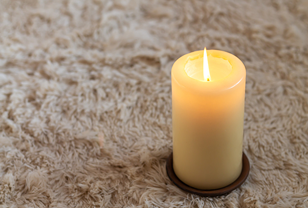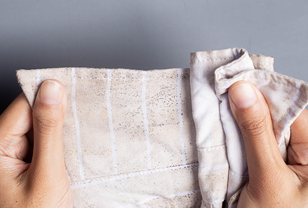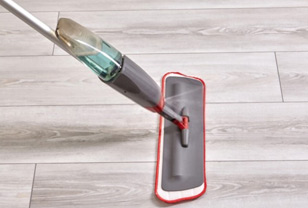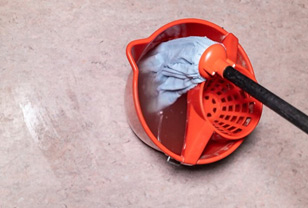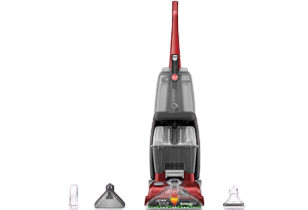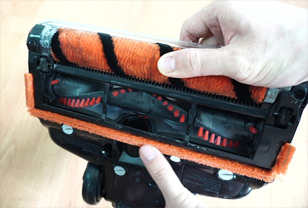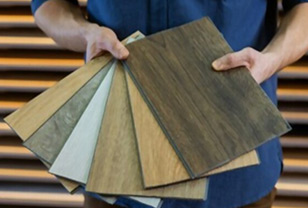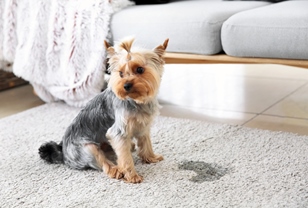How to Wax Tile Floors: A Step-by-Step Tutorial
This process can help retain the shine and beauty of tile floors as well as extend their lifespan. Still, waxing is not a one-size-fits-all solution, and it's never unnecessary to understand the type of tile floors you have and their specific maintenance requirements before attempting to wax them.
In this article, we will explore how to wax tile floors, as well as provide tips and tricks for properly waxing and maintaining your tile floors. Whether you're a homeowner or a business owner, this article will help you keep your tile floors looking their best.
What You Need To Know About Waxing Tile Floors
What Is Waxing?
Waxing is a popular finishing technique that involves the application of a protective wax layer over a floor surface, such as tile floors. In this process, a special waxing solution is spread onto the floor to protect the surface from damage and give it a nice, polished look.
Floor wax is typically made of organic ingredients like carnauba wax and beeswax. Some floor wax for tile products also incorporates plant-based oils.
Recently, synthetic alternatives have gained popularity due to their longer-lasting properties and the absence of natural ingredients that may cause allergies in some people.
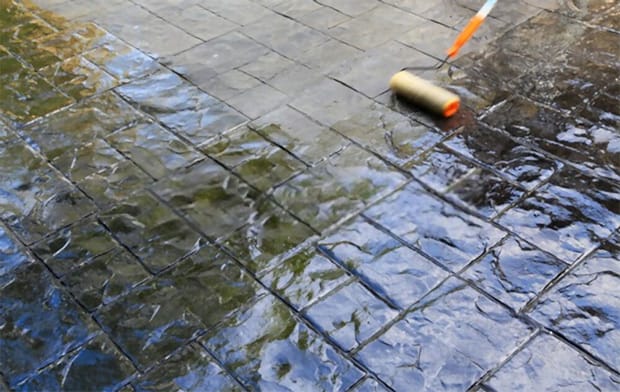
Waxing is a popular finishing technique for many flooring types
Benefits Of Waxing Tile Floors
Waxing tile floors can bring a range of benefits to homeowners. Here are some reasons why you should consider this technique on your tile floor:
- Improved durability: Wax provides a protective layer on the surface of the tile floor, preventing stains, nicks, and scratches. High-traffic areas are more prone to wear and tear, but waxing preserves the floor's surface even in these areas.
- More light to the room: Waxing the floor can create an impression of cleanliness by reflecting light off the surface. Also, the wax provides a shiny finish that can brighten up any room.
- Hidden defects: Waxing can help make marks and dents less obvious. It can provide a more uniform look and feel to the floor, covering up any flaws or imperfections.
- Increased safety: Tile floors can be slippery, especially when wet. Giving them a wax layer can provide more grip and make it less likely for people to fall. This is especially important in high-traffic areas or households with children and elderly people.
- Lower cost: Waxing your tile floor can help avoid permanent damage to the flooring and increase its longevity. This means that you'll have to replace your flooring less often, saving you money in the long run.
Disadvantages Of Waxing
As amazing as it is, there are a few potential downsides of waxing to keep in mind:
- Time-consuming and difficult application and removal: Applying wax to a tile floor can be a labor-intensive task that requires time, attention to detail, and skill to ensure even application. Similarly, removing old wax before applying a new coat can also be challenging and time-consuming.
- Not compatible with all tile floors: Not all types of tile floors are suitable for waxing. Some types of tile, such as those with a rough texture, may not hold wax well or may be damaged by the waxing process. Before deciding to wax your tile floor, it's important to verify that it is compatible with wax and to take any necessary precautions to avoid damaging the surface of the tile.
Different Tile Types And Waxing
If you're wondering whether you can wax your tile floors, the answer depends on the type of flooring you have.
There are many different materials used in tile floors, each with its own unique properties and characteristics. Some types of tile floors can benefit from waxing, while others are simply not suitable for this finishing.
Vitrified Tiles
Vitrified tiles are made from a mixture of clay, silica, quartz, and feldspar that is heated at very high temperatures to create a glass-like surface.
These tiles are extremely durable and resistant to water and stains, making them a popular choice for high-traffic areas like kitchens and bathrooms. Compared to other tile types, vitrified tiles have a low porosity, which means they are less likely to absorb water or dirt.
Waxing is an important step in maintaining vitrified tiles. Applying wax to the surface of these tiles can improve their antifouling and waterproof properties, helping them to resist impact and friction and making them look brighter. Waxing also provides a layer of protection against scratches, nicks, and other forms of wear and tear that can dull the surface of the tile.
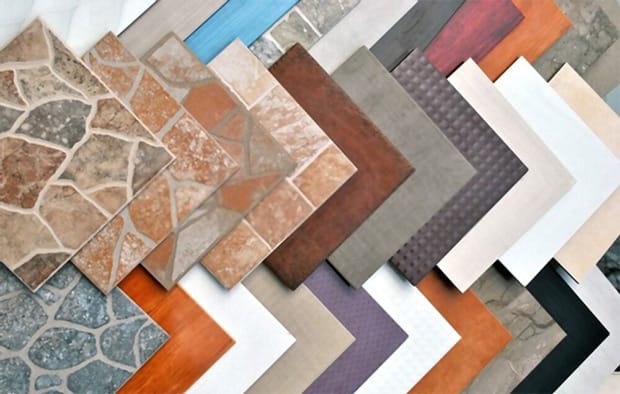
Not every type of tile floor should be waxed
Polished Tiles
Polished tiles are ceramic tiles that are polished to a smooth and glossy finish. They have a sleek and sophisticated appearance but are more prone to attracting dirt and can be slippery.
Waxing can help with both of these issues by providing a protective layer that resists dirt and improving the anti-skid properties of the tile.
However, it is important to note that not all types of polished tile are suitable for waxing, so it is best to check with the manufacturer or a professional before attempting to wax your polished tile floor.
Glazed Tiles
Glazed tiles, including porcelain tiles, typically do not require waxing.
They have a smooth, non-porous surface that does not absorb much wax. Applying wax to glazed tiles would be ineffective, as the wax would simply sit on the surface without being absorbed, defeating the purpose of this process.
Instead, a better option for these tiles is to use a sealant, which can provide similar benefits to waxing, such as protection against stains and spills. However, sealant provides a more permanent solution as it does not need to be reapplied as frequently as wax.
In addition, a sealant is more suitable for high-moisture areas such as bathrooms and kitchens as it provides better resistance to water and humidity.
Natural Stone
Natural stone tiles, such as marble, should not be waxed. Waxing can actually make the surface duller and attract more dirt and grime. Instead, cleaners and sealers designed for these porous surfaces are recommended.
Other methods of polishing, such as honing or buffing, are also preferred over waxing. It is important to use the right products and methods for natural stone tiles to prevent damage and maintain their natural beauty.
Floor Wax Types
There are different types of wax available, including solid paste and liquid, each with its own unique benefits and drawbacks.
Paste wax, also known as solid wax, has a thicker consistency and is more durable. It requires fewer coats but can be more difficult to apply evenly.
On the other hand, liquid wax is much easier to apply, as it only needs to be spread across the surface and does not require heavy rubbing. However, the coating may not be as durable as that of paste wax.
When waxing tile floors, it's important to choose the right type of wax based on the level of traffic it receives and follow the proper application techniques.
Things You Will Need
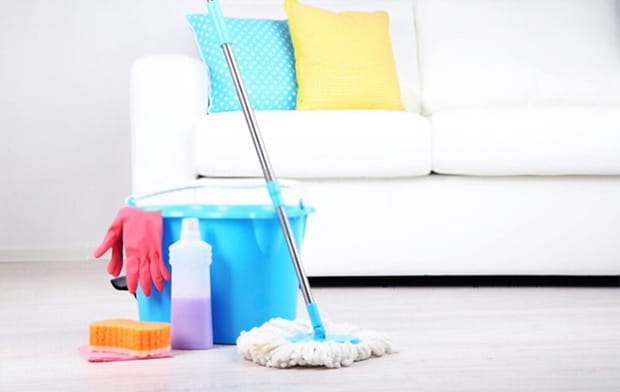
Gather all the things you need beforehand
Here's a list of tools and supplies that you will need when waxing a tile floor. It's important to have all of these items on hand before starting the waxing process. Some of them, like the broom or vacuum cleaner, are needed for floor preparation, while others will be used for applying the wax itself.
- Broom and dustpan
- Vacuum cleaner
- Mop and bucket
- Sponge mop or wax applicator
- Wax stripper solution (if removing old wax)
- Scrubber pad (if removing old wax)
- White vinegar
- Warm water
- Soft-bristled brush
- Commercial tile cleaner (optional)
- Wax (solid paste or liquid)
- Wax applicator pad (for solid paste wax)
- Plenty of clean towels or rags
Floor Preparation
Preparing the floor before waxing tile floors is crucial for achieving a smooth and long-lasting finish. This involves several important steps, including removing furniture and appliances from the area, thoroughly cleaning the floor, and removing any old wax.
While it may be tempting to skip these steps, doing so can lead to unsightly and uneven results, as well as premature wear and tear on your flooring. By taking the time to properly prepare your floor, you can ensure that your new wax coating adheres evenly and lasts longer while also preventing damage to your furniture and appliances during the waxing process.
Removing Furniture
Removing furniture and appliances, such as throw rugs, chairs, and tables, from a tile floor before waxing is crucial to ensure that the entire surface is evenly coated with wax.
If you don't move these items, you may end up with spots on the floor that don't have any wax, or even worse, you could accidentally get wax on your furniture or appliances.
When moving them, take care to lift them instead of dragging them, which can scratch or damage the floor. Additionally, if you are unable to move a heavy item, cover it with plastic or a drop cloth to protect it from any wax splatters or spills.
Clean The Floor
Cleaning your tile floor thoroughly before waxing is key to preventing any dirt, crumbs, or stains from being sealed under the wax coating.
If you don't get rid of them from the flooring before waxing them, they will stay there on the surface permanently. This also gives a chance to remove the old wax layer if your flooring already has one.
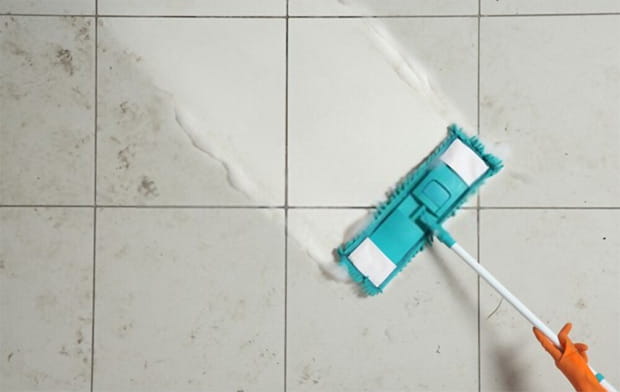
Clean the floor before waxing it
Over time, the wax buildup can become discolored, scratched, or uneven. This can affect the appearance of the floor and make it harder to clean. Removing the old wax also allows the new wax to penetrate the surface of the tile and create a stronger bond, resulting in a more durable finish.
- To start the cleaning process, you should sweep or vacuum the surface with a broom or vacuum cleaner. Pay special attention to the corners, edges, and baseboards, where dirt and dust tend to accumulate. Some can invest in the best tile floor cleaner machine for this task.
- After that, prepare a homemade cleaning solution by mixing 1/2 cup of vinegar with 1 gallon of warm water and adding a few drops of dish soap.
- Once the solution is ready, you can dip a mop into the mixture and wring it out until it's damp. Then mop the entire surface of the tile floor, paying attention to any areas with stains or spots. If necessary, you can use a scrub brush to gently agitate any stubborn spots.
- If you have an existing wax layer that needs to be removed, let the vinegar solution sit on it for a few minutes so the wax can be softened. In addition to a scrub brush, you can also scrub the old wax away with a wood pad.
- For the most stubborn spots, you may need to use a commercial cleaner or spot treatment solution. However, in most cases, the homemade vinegar solution should do the trick.
- Once the floor is clean and dry, you can proceed with the waxing.
How To Wax Tile Floors
- Choose the appropriate mop for your wax type. Use a flat wax applicator for solid paste wax or a sponge mop for liquid wax. If possible, use a new one to prevent dirt from getting on your floor. This will ensure the quality of your floor coating is not compromised.
- Line your mop bucket with a trash bag if using a sponge mop to prevent wax from caking on the bucket and rendering it unusable in the future. This step is not necessary for a floor wax applicator.
- Dip your sponge mop into the wax to saturate it, or pour wax onto the wax applicator. Ensure that you have enough wax on your mop, but be careful not to make it too dry or too waxy, which could cause excess wax to drip onto the ceramic tiles.
- Begin applying wax to the interior end of the room, working your way toward the door. This will prevent you from crossing the newly waxed surface when exiting the room.
- After completing a section, use broad strokes with your mop to give the surface a smooth appearance.
- Allow the first coat to dry for approximately one hour before applying the second coat. Repeat the process for each additional coat.
- After applying the final coat, allow it to dry completely while you clean all of the tools and equipment that were used.
- If recommended by the manufacturer, buff the floor to achieve a glossy finish. Otherwise, let the floor dry for about a few hours (or, even better, overnight) before returning the furniture to the room.
Tips On Waxing Tile Floors
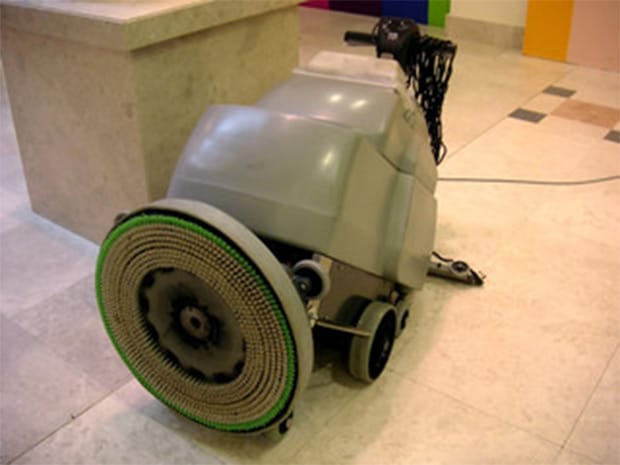
You can always hire a professional with a floor waxer
Waxing tile floors is a great way to keep them looking shiny and clean. However, it is important to approach the process with care to avoid any unwanted outcomes. Keep these tips and warnings in mind before you wax your floor:
- Before beginning, it is essential to ensure that the floor is completely dry.
- Once this is confirmed, the wax should be applied evenly across the surface of the floor, taking care to avoid leaving any spots or streaks.
- It is also important to allow the floor to dry after it has been waxed. To speed up the drying process, you can use electric fans to help circulate the air and promote evaporation. Remember to keep children and pets away from the freshly waxed floor during this time.
➜ RELATED: Best Broom For Tile Floors: TOP Product Review & Buying Guide
Tips On Using And Maintaining Waxed Tile Floors
Maintaining a waxed tile floor is an important part of preserving its appearance and longevity.
- One of the best ways to keep a waxed tile floor looking great is to use soft microfiber brooms and mops when cleaning it. Traditional brooms and mops can be too rough and can scratch or damage the wax coating, which will ruin the look of the room. Microfiber brooms and mops are gentle enough to use without damaging the wax, and they are also more effective at removing dirt and debris from the floor.
- Another important tip for maintaining a waxed tile floor is to avoid using harsh chemicals or abrasive cleaners. They can strip away the wax coating and leave the tiles vulnerable to damage. Instead, use a mild, pH-neutral cleaner designed specifically for use on your waxed floors. These cleaners will remove dirt and stains without harming the wax coating or the tiles themselves.
- Finally, give the waxed tile floor time to dry completely after cleaning it. If the floor is still wet when furniture or other objects are placed on it, they can leave marks or dents in the wax coating. Using electric fans to help the floor dry more quickly can be a great way to minimize the risk of damage.
Conclusion
Waxing tile floors is not an easy task and requires proper technique to achieve the desired results.
While there are various types of wax available, each tile material has its own distinct properties and compatibility with different waxes. It is important to check the manufacturer's recommendations before attempting any major modifications, like waxing.
With proper maintenance and cleaning, tile floors can last a lifetime, adding beauty and functionality to any home. While waxing is an effective way to enhance shine and protect the tile surface, remember to use caution and care when applying the wax.
By following these guidelines and learning how to wax tile floors correctly, homeowners can enjoy the benefits of an enhanced tile floor with minimal hassle and maximum satisfaction.
FREQUENTLY ASKED QUESTIONS
- 01. Can You Wax Tile Floors?
-
The answer depends on the type of tile.
Some tile floors, like natural stone, polished tile, or glazed tile, may not need waxing or may even be harmed by it. However, other types of tile floors, such as unglazed porcelain or concrete, can benefit from waxing as it can provide extra protection and shine.
You should always check the manufacturer's instructions or consult a professional before applying any wax.
- 02. Can You Wax Ceramic Tiles?
-
It depends on the specific tile product you have. Ceramic tile is usually glazed, which means that it doesn't absorb wax well and may not need it. However, if the ceramic tile is unglazed, it may benefit from the best wax for ceramic tile floors to protect it from stains and damage.
- 03. Is It Safe To Walk On A Freshly Waxed Floor?
-
It's generally safe to walk on a freshly waxed floor, but it's important to wait until the wax is fully dry and cured before doing so.
The time needed for the wax to dry can vary depending on the type of wax and the environmental conditions. The manufacturer of the wax may have specific recommendations for this.
- 04. How To Strip And Wax Floors Without A Machine?
-
Stripping and waxing floors without a machine can be done manually, but it's a labor-intensive process. It involves using a stripping solution to remove the old wax, scrubbing the floor with a brush, rinsing with water, and then applying the new wax.
- 05. How To Clean Tile Floors With Vinegar?
-
Mix one part vinegar with ten parts water and apply the solution to the floor with a mop. Rinse with clean water and dry the floor thoroughly. Avoid using vinegar on natural stone or waxed tile floors, as it can harm the surface.
➜ RELATED: How To Clean Tile Floors With Vinegar, Baking Soda, And Lemon?


